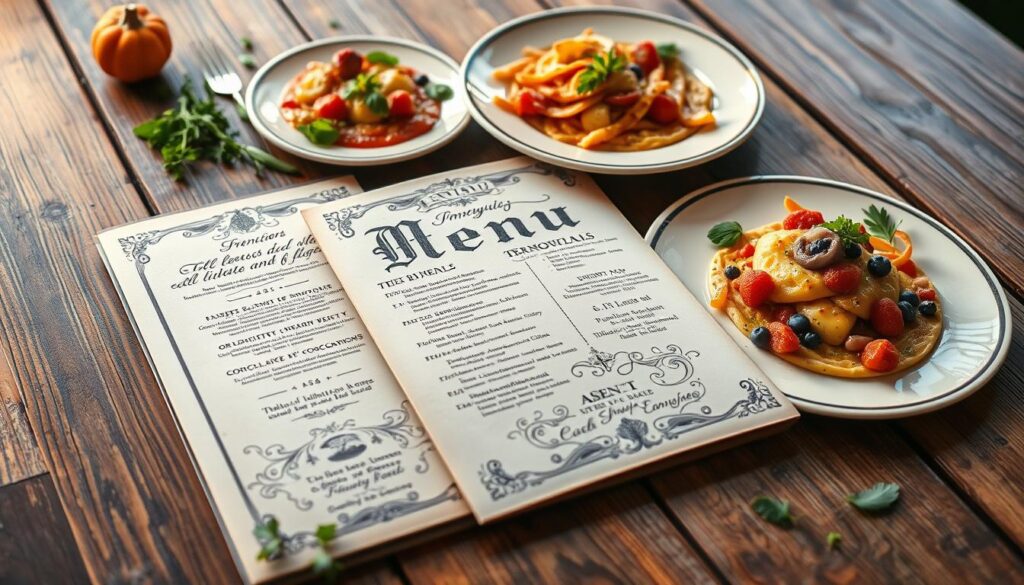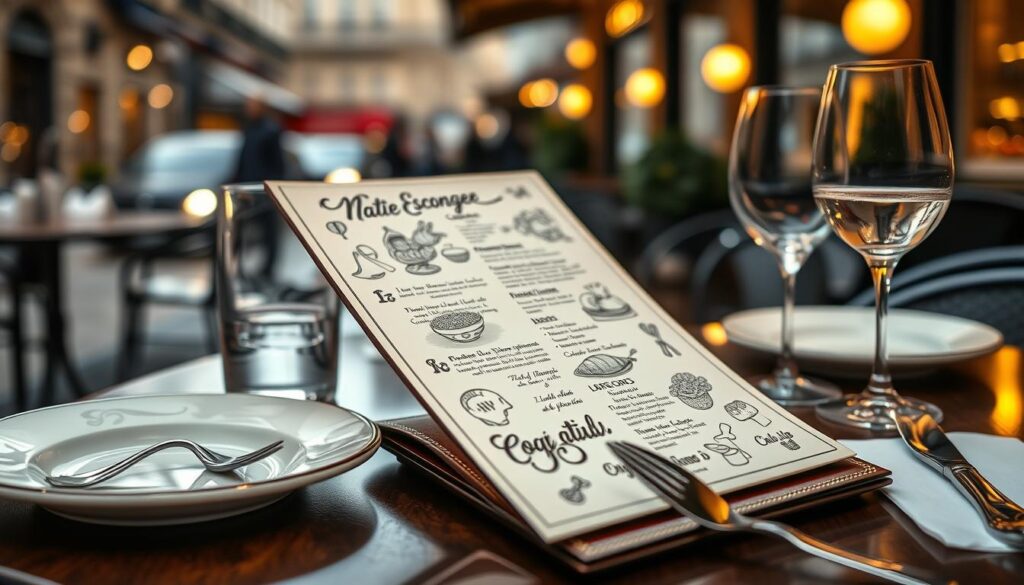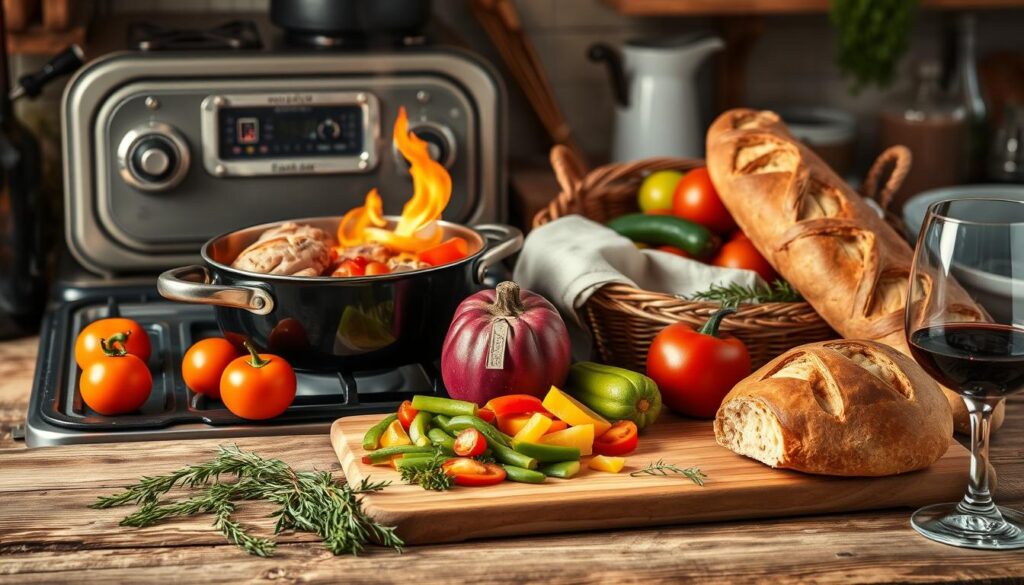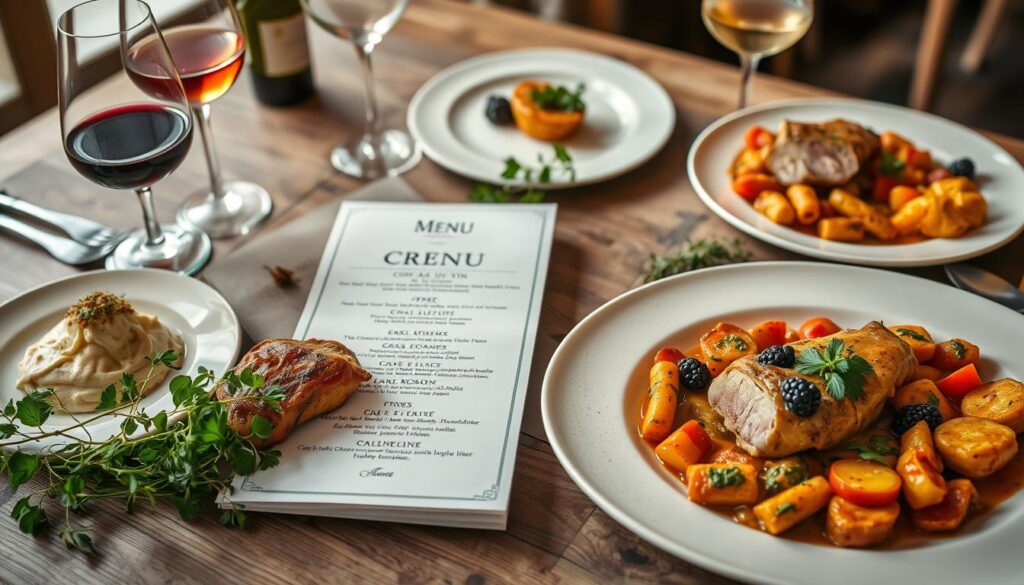Imagine walking the historic cobblestone streets of Paris, feeling a gentle breeze and catching the scent of fresh baguette in the air. You step into a quaint bistro, the rich melody of the French language envelops you, and a waiter presents you with a menu. But this is no ordinary menu; this is your passport to truly understanding French food terms. From ‘bœuf bourguignon’ to ‘tarte tatin’, every dish tells a story.
Much more than a simple list, learning how to read French menus is about experiencing culture on a plate. As I guide you through the picturesque gastronomic landscape, you’ll find out why the seemingly familiar ‘menu’ is anything but when in Paris. This is your very own French menu guide, a beacon through the delightful complexity of French culinary traditions. The journey into French dining starts here.
Key Takeaways
- Gain a cultural edge by understanding what constitutes a ‘menu’ or ‘à la carte’ in Parisian restaurants.
- Discover a dining rhythm that emphasizes leisure, appreciation, and etiquette unique to France.
- Learn the importance of making and confirming reservations to ensure a spot at Paris’s sought-after eateries.
- Embrace the norm of using cutlery for most foods, even the unexpected ones like burgers.
- Understand how to conclude your meal on the right note, from signaling the server to requesting the bill.
The Mystery of ‘Le Menu’ and ‘La Carte’
Welcome to the world of French dining. Here, knowing ‘le menu’ and ‘la carte’ is key for a real French food experience. It might seem tricky at first, but I’m here to help you through it.
Understanding French Dining Etiquette
To enjoy French dining, you need to know the etiquette. It’s not just about the food; it’s an art. People in France love to eat together, often late into the night.
Lunches are big deals, with many courses. This helps you understand the menu better.
What ‘Menu’ Really Means in Paris
In Paris, ‘menu’ means a fixed-price meal with several courses. It’s different from what you might expect. This format makes choosing easier and shows the local dining culture’s elegance.
The Difference Between ‘Carte’ and ‘Menu’
‘La carte’ is different from ‘le menu’ in Paris. ‘Le menu’ is a set meal, while ‘la carte’ lets you pick dishes yourself. Knowing this helps you tailor your meal to your taste.
This choice makes your dining experience unique. You can choose a set meal or pick dishes on your own.
Learning about French dining will make your meals more enjoyable. It lets you connect with the French culture. Every meal becomes a special experience.
How to Read French Menus
When you sit in a Parisian café, ready to try local food, knowing how to translate French menu is key. A French menu starts with an apéritif and goes through courses like entrée (starter), plat principal (main course), and ends with dessert, café, and digestif. Each dish is chosen to work well with the next, making a complete meal.

The plat du jour, or daily special, is a highlight in the meal. It shows the freshest ingredients. Understanding French menus means more than just translating words. It’s about the culture and meaning behind each dish.
- Fixed-price Menus: Known as menu, it’s not just one dish. It’s usually two or more courses, like an entrée and a plat, or a plat and a dessert. It’s a good deal for trying a full meal.
- La Carte: Here, you’ll find all the dishes the restaurant offers. It’s like an à la carte menu, where each item has its own price.
- La Carte des Vins: This is the wine menu. It’s important for those who want to match their meal with the perfect wine. It’s a big part of the French dining experience.
| Term | Translation | Description |
|---|---|---|
| Menu Dégustation | Tasting Menu | A multi-course meal designed by the chef to showcase their best dishes. |
| Gratuit/Offert | Free | These terms indicate that something on the menu comes without additional charge. |
| Plat du Jour | Daily Special | The dish prepared for that particular day, often seasonal and priced reasonably. |
| Carte des Vins | Wine List | A detailed list of available wines, sometimes with recommendations for pairing. |
As you translate the French menu, you’ll see cooking terms like maison (homemade), poêlé (panfried), and frit (fried). These terms show how the food is made. Knowing them makes your meal more enjoyable, as you appreciate the effort put into each dish.
Knowing how to translate a French menu makes your food adventures better. It helps you go from being a tourist to truly enjoying French dining. With this skill, you can pick any dish with confidence, making every meal special.
Translating Common French Food Terms
Exploring French food can be both exciting and challenging. Learning some French food terms makes dining in France more enjoyable. It also helps understand the poetic menus found in Parisian bistros and Provencal eateries.
Navigating French Restaurant Menus with Key Vocabulary
French menus are delightful but can be tricky to read. From apéritif to digestif, each course is important. An apéritif is a drink to start, while entrées (starters) might include soupe à l’oignon (onion soup).
The plats principaux (main courses) come next, with dishes like coq au vin (chicken cooked in wine). A plat du jour (dish of the day) is often highlighted, such as seared scallops or boeuf bourguignon.
Don’t forget the desserts like crème brûlée or macarons for a sweet end. For vegetarians, knowing ‘sans viande’ means without meat is key.

Tips for Deciphering French Menus: From Appetizers to Desserts
In France, you’ll find both fixed and à la carte menus. Fixed menus offer a set of choices, while à la carte menus let you pick what you like. This means you can mix and match courses, like entrée of escargots (snails) with a plat of gigot d’agneau (leg of lamb).
When looking at a French menu, each category shows the culinary delights of the region. Knowing cooking styles like grillé (grilled) or poêlée (sautéed) helps choose dishes that fit your taste. A complete meal often includes légumes (vegetables) like gratin dauphinois (potatoes in cream sauce) or regional specialties.
So, next time you’re in a French restaurant, like Les Voiles or Bistrot des Moines, use these tips for deciphering French menus. Each dish is a story of regional flavors and the chef’s skill, meant to be enjoyed one course at a time!
French Cuisine Vocabulary: Meat, Fish, and Vegetables
French cuisine has a vast vocabulary, covering meats, fish, and vegetables. It’s not just about decoding French menus. It’s about diving into the culture and tradition behind each dish. Let’s explore some key categories.
Decoding Meat Dishes: Beef, Pork, and Poultry
French cuisine boasts a wide range of meats, from beef to poultry. Knowing these terms makes dining in France more enjoyable. For example, ‘boeuf’ (beef) might lead you to ‘boeuf bourguignon’, a classic dish. ‘Canard’ (duck) is often served as ‘confit de canard’, a dish known for its rich flavor.
These are just a few examples from a vast array of meat and poultry terms. France offers over 40 different types, including lamb, rabbit, and wild boar.
Seafood Specialties: Understanding ‘Fruits de Mer’
Seafood, or ‘fruits de mer’, is crucial in French cuisine. It includes a variety of sea creatures, from ‘homard’ (lobster) to ‘huîtres’ (oysters). There are about 19 seafood terms, each unlocking a unique dish.
For instance, ‘bouillabaisse’ is a famous fish stew from Provence. It combines fresh fish and shellfish, showcasing the diversity of French seafood.
Veggies and Sides: A Guide to French ‘Légumes’ and ‘Accompagnements’
Vegetables (‘légumes’) are more than just sides in French cuisine. They’re essential, enhancing the main course. Terms like ‘asperges’ (asparagus) and ‘épinards’ (spinach) help you choose the right ‘accompagnements’, like ‘ratatouille’. This dish highlights the richness of French vegetables.
With about 13 vegetable terms on menus, there’s something for everyone. Exploring these terms can make dining in France a true culinary adventure. For a deeper dive, check out the food dictionary at Cellar Tours.
A Closer Look at French Cooking Methods
Exploring French cooking methods lets us see the artistry of French cuisine. It’s a journey through flavors and techniques that enrich our dining. Whether in Paris or a countryside bistro, knowing these methods changes how we see French food.
From ‘Grillé’ to ‘Poché’: Cooking Techniques on French Menus
Looking at a French menu, I see many cooking methods. ‘Sauté’, ‘braise’, and ‘grillé’ each add something special to a dish. ‘Confit’, where food is cooked slowly in grease or sugar water, brings deep flavors.
French Menu Guide: The Significance of Preparation Methods
Learning about these methods makes me appreciate the menu more. ‘Poché’, for example, cooks food gently in liquid, keeping its flavor and texture. Each term on the menu tells a story of tradition and history, turning simple ingredients into culinary wonders.
Modern menus show the influence of historical chefs like Marie-Antoine Carême and Georges Auguste Escoffier. Today’s chefs honor their legacy with careful techniques and beautiful presentation.
| Technique | Description | Common Dishes |
|---|---|---|
| Grillé | Grilling over an open flame | Grilled steak, seafood |
| Braise | Slow cooking in covered pot with minimal liquid | Beef Bourguignon, Coq au vin |
| Poché | Gentle simmering in water or wine | Poached eggs, poached fish |
| Confit | Slow cooking in oil or grease at low temperature | Confit de canard, garlic confit |

French chefs blend tradition and modernity, offering more than just taste. It’s a journey into French culture through food. Each dish tells a story of culinary artistry, passed down through generations, waiting to be enjoyed.
The Art of Ordering a French Meal
Ordering in a French restaurant is more than just picking food. It’s about diving into the local culture. Whether you choose a ‘menu’ or ‘à la carte’, it’s a journey of discovery.
Selecting Courses: How the French Do It
In France, meals have several courses. You start with an entrée (starter), then a plat principal (main course). Finally, you might have cheese or dessert.
Start with small portions that grow in size. Wait for everyone to be served before you begin. This shows respect and makes the meal more enjoyable for everyone.
French Menu Translation: A Practical Walkthrough
Translating menus can be helpful for your friends. It helps them understand the food better. Let’s look at what you might find on a French menu:

- Entrées: These are light and refreshing. You might find escargots au beurre (snails in butter) or consommé d’asperges (asparagus consommé).
- Plats Principaux: Your main course could be meat or seafood. Knowing the menu helps you choose what you like.
- Fromages et Desserts: Cheese comes before dessert. Saying ‘Je voudrais le plateau de fromages, s’il vous plaît’ (I would like the cheese platter, please) is helpful.
Here’s a table to help you understand French courses better:
| Meal Time | Typical Courses | Culinary Terms |
|---|---|---|
| Lunch (Le Déjeuner) | Entrée, Plat Principal, Dessert | Entrée: Salade Niçoise, Plat Principal: Boeuf Bourguignon, Dessert: Tarte Tatin |
| Dinner (Le Dîner) | Entrée, Plat Principal, Fromage, Dessert | Entrée: Foie Gras, Plat Principal: Coq au Vin, Fromage: Camembert, Dessert: Crème Brûlée |
Exploring Paris can make you hungry. Knowing how to order in a French restaurant is key for food lovers and curious travelers.
The Flavors of France: Describing Taste and Texture
Exploring French cuisine is more than just eating. It’s about understanding describing taste and texture. Knowing how to translate French menu terms helps diners enjoy their meals fully.
French dishes vary by region, each with its own unique flavors. For example, Normandy’s Camembert is creamy and aromatic. Burgundy’s Boeuf Bourguignon is robust and earthy. These dishes show the local traditions and history of each area.
When describing flavors and textures, it’s key to use terms like croustillant (crispy) and onctueux (creamy). These words not only describe the food’s physical qualities but also enhance the dining experience. They create a vivid picture of each bite.
Visiting French markets on a Sunday can deepen your appreciation for these tastes. It shows how they are a big part of French life.
Here’s a table outlining some key regional dishes along with the specific flavors and textures they are known for:
| Region | Dish | Flavor Profile | Texture |
|---|---|---|---|
| Normandy | Camembert Cheese | Rich, creamy | Soft, yielding |
| Burgundy | Boeuf Bourguignon | Savory, deep umami | Tender, succulent |
| Provence | Ratatouille | Herbaceous, fresh | Chunky, varied |
| Aquitaine | Confit de Canard | Rich, meaty | Crispy on the outside, tender inside |
| Rhône-Alpes | Raclette | Hearty, salty | Smooth, molten |
Exploring French cuisine’s flavors and textures is a delicious way to see regional diversity and culinary skill. Whether it’s an Alsatian Riesling or a Provence Ratatouille, each element adds to the rich French dining experience.
Conclusion
Starting the journey of French menu translation is more than just eating. It’s diving into France’s rich food story. I’ve learned to read French menus and find my way through different restaurants. From Parisian brasseries to small cafés, I’ve discovered a lot.
I found out about ‘le menu’ and ‘la carte.’ I learned about set menus and dishes from around the world. From traditional meats to North African dishes and fusion food, it’s been a feast for my taste buds.
This journey has taught me more than just about food. It’s shown me the beauty of French dining. I’ve learned to enjoy busy brasseries and mid-range restaurants where locals go for lunch.
I’ve also learned about French customs, like saying ‘Je voudrais’ when ordering. And how to tip politely. Even without many vegetarian options, I always found something delicious. The joy of ‘menu gastronomique’ stayed with me long after the meal.
I hope my story inspires others to have amazing French dining experiences. Knowing about dietary needs, etiquette, and service makes the journey richer. From menus outside restaurants to how proteins are prepared, it’s a journey into French life.
To those exploring French food, I say ‘Bon appétit.’ I encourage you to dive into the world of French menus. It’s a journey of flavors and culture waiting to be discovered.
FAQ
How do I read a French menu?
To read a French menu, knowing some basic terms is key. Look for ‘petit déjeuner’ for breakfast, ‘déjeuner’ for lunch, and ‘dîner’ for dinner. Find ‘entrée’ (appetizer), ‘plat’ (main course), and ‘dessert’ (dessert) to follow the meal’s flow.
Remember, ‘menu’ means a fixed-price meal, while ‘à la carte’ lets you pick dishes individually.
What’s the difference between ‘le menu’ and ‘la carte’ in a French restaurant?
‘Le menu’ is a prix-fixe meal with a set number of courses at a fixed price. ‘La carte’ lists all dishes available for you to choose from.
What does ‘menu dégustation’ mean?
‘Menu dégustation’ is a tasting menu with small portions of the chef’s best dishes. It’s a way to try the restaurant’s top offerings in one meal.
How can I navigate French restaurant menus with key vocabulary?
Learning words like ‘viande’ (meat), ‘poisson’ (fish), ‘salade’ (salad), and cooking methods like ‘grillé’ (grilled) or ‘poêlée’ (pan-fried) helps. Knowing ‘sans’ (without) is also useful for dietary needs.
What are some common French food terms for meats?
Key terms for meats include ‘boeuf’ (beef), ‘porc’ (pork), ‘canard’ (duck), and ‘poulet’ (chicken). These help identify the meat in dishes.
What should I expect under ‘fruits de mer’ on a French menu?
‘Fruits de mer’ means seafood and often includes ‘homard’ (lobster), ‘moules’ (mussels), ‘huîtres’ (oysters), and more.
Are there any tips for deciphering French menus when it comes to sides and vegetables?
Yes, knowing ‘légumes’ means vegetables and ‘accompagnement’ means sides helps. Common sides include ‘pommes frites’ (French fries), ‘salade verte’ (green salad), or ‘gratin dauphinois’ (scalloped potatoes).
How do French cooking methods affect my menu choice?
French cooking methods like ‘rôti’ (roasted), ‘braisé’ (braised), ‘poché’ (poached), and ‘saignant’ (rare) change flavor and texture. Knowing these terms helps choose dishes that match your taste.
How do I order in a French restaurant?
You can choose ‘le menu’ for a set meal or ‘à la carte’ for a personalized meal. When ordering meat, specify your preferred doneness, like ‘saignant’ (rare) or ‘bien cuit’ (well-done). Asking for recommendations is also appreciated.
How are taste and texture described on a French menu?
Flavors might be ‘aigre-doux’ (sweet and sour), ‘épicé’ (spicy), or ‘sucré’ (sweet). Textures could be ‘croustillant’ (crispy), ‘onctueux’ (creamy), or ‘fondant’ (melting). These descriptions aim to give you a sense of the dish’s taste and feel.
Hi, I’m Tiana – founder of and author here at Where Tiana Travels. I’m a 20-something with a love for all things travel, photography, and food. I have been living abroad for the past 5 years and solo traveling the globe in my free time. I created this blog to share my travel stories and inspire other women to go out and see the world. Read more about me here!

